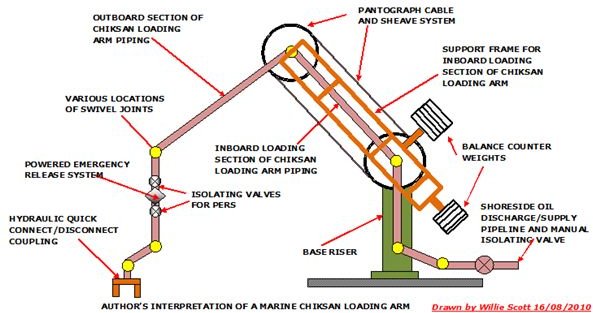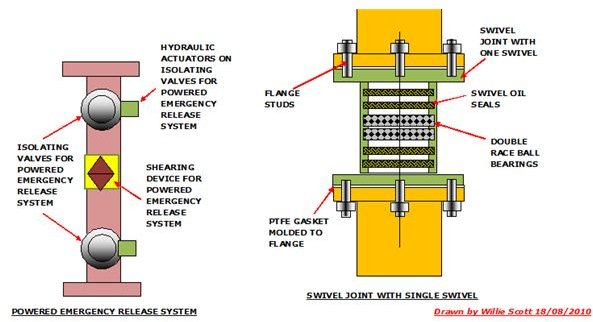Maintenance of Chiksan Valves and Swivel Joints
Introduction
I first came across Chicksan (sometimes called chicksan) loading arms in the mid-sixties, whilst serving as a Junior Engineer on an oil tanker. We were loading crude in the Persian Gulf, and I was amazed at the automatic adjusting that the chicksan arms performed as the oil was loaded through them. This was due to the swivel joints which ensure the connecting piping is not put under undue stress.
If stress levels do become too high, an automatic Powered Emergency Release System (PERS) operates, disconnecting the piping from the ship, closing the isolating valves on each side of the system, and stopping the onshore cargo pumps, avoiding oil spillage.
The swivel joints and PERS isolating valves are the most important components on the loading arm and must be regularly maintained to ensure operation. This is an article on the care and maintenance of Chiksan loading arm swivel joints and PERS isolating valves. We shall examine the operation of a typical Chiksan loading arm used in shore and offshore applications and we begin with their care and maintenance requirements.
Care and Maintenance of Chiksan Swivel Joints and Emergency Release System Isolating Valves
Swivel Joints
There are three types containing one, two, or three swivels being fitted at various locations to adjust the orientation of the loading arm piping as the ship is being loaded or discharged whilst maintaining internal oil sealing, combined with external water and dust exclusion.
Care and Maintenance.
- Seals
The seals (PTFE for oil) should be checked regularly for wear or surface scores due to the corrosive and abrasive nature of crude.
Any damaged or worn seals must be replaced with new ones
- Ball races
The ball races (double races for oil) are sealed from the crude; however these seals can also be compromised by the passage of the crude or excessive stressing.
- Flange Connections.
Some types of swivels joints are supplied with flanges coated in PTFE which acts as a gasket. Any leaks from damage to this and the flange will require cleaning up and the gasket replaced using a proprietary oil gasket material.
PERS Isolating Valves
In the event of an emergency such as a fire or mooring line parting, the PERS automatically releases the loading arm piping from the ship. Two stainless steel spring loaded ball valves, one each side of the PERS automatically shut, preventing any oil spillage from the piping ends.
Care and Maintenance
- Valve Inspection
These valves are sealed, stainless steel, spring loaded ball valves, therefore care and maintenance is limited to checking electrical and hydraulic connections, and checking for oil leaks from flanges or glands. If any leaks found cannot be stopped by re-tightening, the complete valve should be replaced.
Reference Web:
- chiksan - Chiksan loading arms
- oreytecnica - swivels and PERS sytem valves
Applications of Chiksan Loading Arms
Onshore
- Loading and discharging oil and LNG tankers at terminals.
- Loading and discharging of oil and LNG railcars and tanker trucks.
- Used in oil and gas refineries
- Used in land based oil field production facilities.
Offshore
- Loading fuel and water to offshore oil and gas production platforms and drilling rigs bunker tanks.
- Transferring oil form Floating Production and Storage Offloading ships (FPSO)
Reference Webs:
1. chiksan - truck and railcar loading arms.
2. chiksan - marine loading arms.
3. chiksan - oil refinery applications.
Description and Operation of Chiksan Marine Loading Arm Components.
1. Inboard arm.
This is the arm which connects to the suction and discharge flanged pipes on the deck of the tanker.
2. Outboard Arm.
This is the arm which is located on the jetty side of the terminal being bolted onto the base riser.
3. Base Riser.
The base riser is mounted on the jetty and supports the weight of the loading arm. It also provides the connection to the loading arm piping from shoreside storage tanks and pumps.
4. Swivel Joints
The swivel joint is undoubtedly the heart of the whole system. Consisting of three types containing one, two, or three swivels, it adjusts of the orientation of the loading arm piping as the ship is being loaded or discharged.
Swivel joints also maintain internal oil sealing, combined with external water and dust exclusion. They operate efficiently and smoothly due to integrated self-lubricating PTFE seals and a double row of ball bearings.
The different types of Swivel joints are fitted to the various sections of the loading arm pipework which are put under stress due to the tankers listing movements during cargo operations.
5. Powered Emergency Release System
The Powered Emergency Release System (PERS) allows for almost instant release of the connecting loading arm pipework between the jetty and the tanker in an emergency situation.
A stainless steel spring loaded, self-closing ball valve is fitted each side of the PERS that ensures virtually no spillage due to a sudden emergency disconnection of the pipework.
On the operation of the PERS, an alarm is triggered that automatically shuts-down the shoreside oil supply pumps and disconnection of the hydraulic coupling enabling the inboard section of the arm to be maneuvered from the ships connections
6. Hydraulic Quick Connect/Disconnect Couplings.
These are used to connect the inboard arm piping flanges to the ships suction and discharge flanges. They are adjustable to fit several standard sized flanges, being easily fitted without the use of flange bolts, washers, and the use of spanners.
7. Control Cables.
These cables are wound around the control wheels on the inboard and outboard sections, and allow the accurate location of the suction and discharge flanged pipes on the inboard arm section of the loading arm.
8. Counter Balance Weights.
These are positioned in different locations depending on the model and application of the loading arm; being used to counter-balance the weight of the outboard arm, assisting in smooth adjustment of the inboard arm.
Reference Webs:
Sketch of a Basic Chiksan Marine Loading Arm, PERS Valves, and a Swivel Joint.

